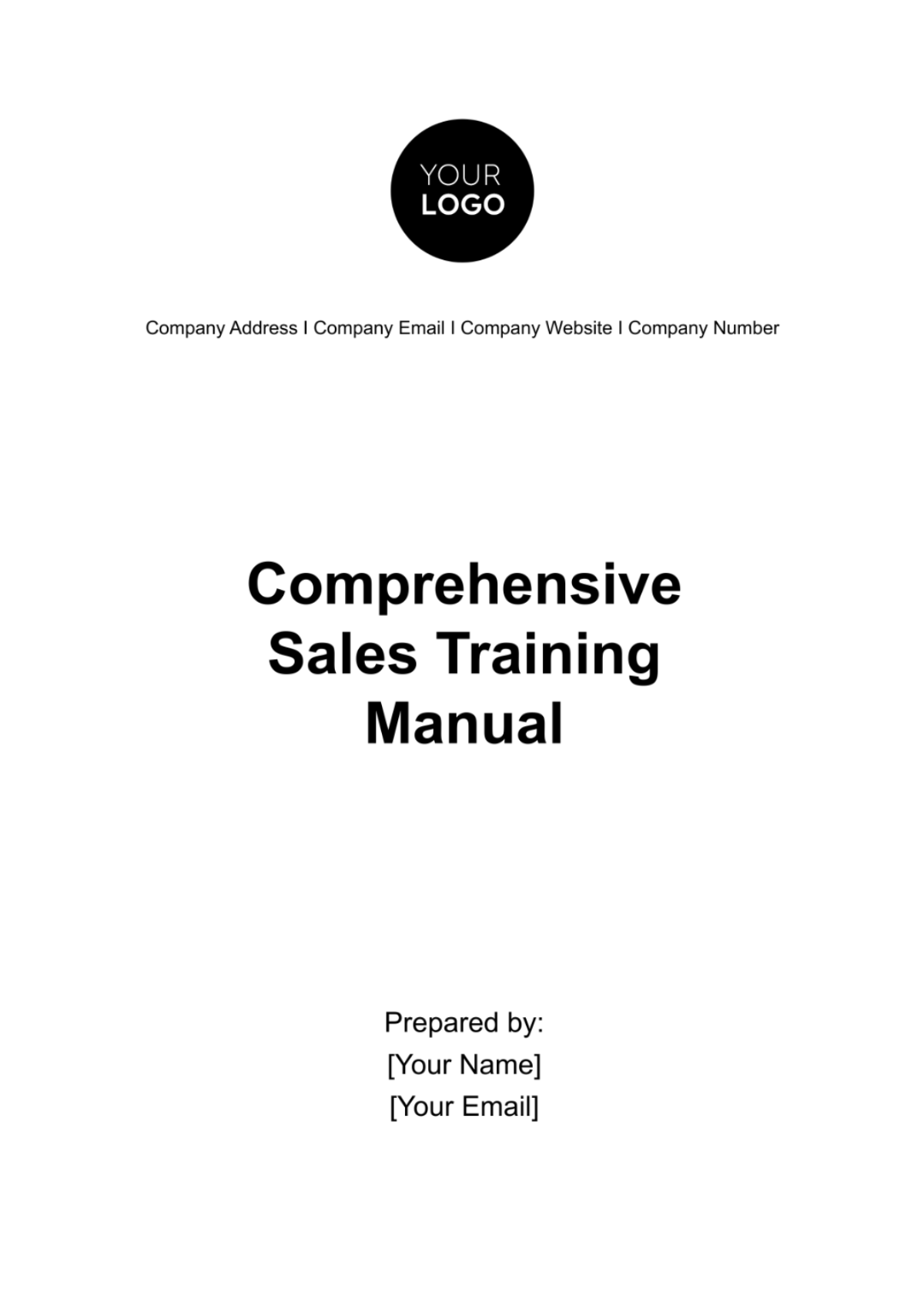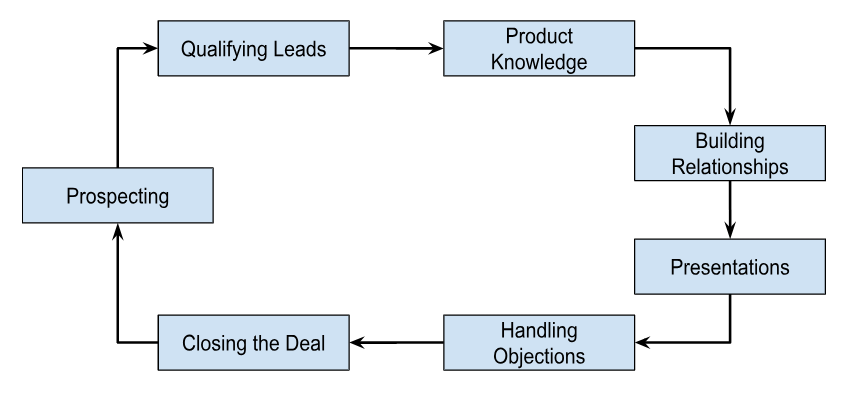Free Comprehensive Sales Training Manual

Purpose of This Manual
The [Your Company Name] Sales Training Manual stands as a beacon of knowledge, meticulously crafted to serve as a compass for our sales professionals as they navigate the intricate and dynamic world of sales. This comprehensive manual serves as a guiding light, illuminating the path toward sales excellence. Within these pages, our team members will discover invaluable insights into the complete sales process, from prospecting to post-sale follow-up. Additionally, this manual provides a deep dive into the core tenets of sales success, including essential sales techniques and the art of effective communication. It is our unwavering belief that through the knowledge imparted in this manual, our sales professionals will not only achieve personal growth but also continue the rich tradition of [Your Company Name] by setting new benchmarks in the industry.
1. The Sales Process
The sales process consists of several key stages:

Stage 1. Prospecting
Prospecting involves identifying and nurturing potential customers. Utilize various sources, such as social media, industry events, and referrals, to generate leads.
Stage 2. Qualifying Leads
Before investing time and resources, assess whether a lead is genuinely interested and can afford your product or service. This ensures efficient use of your sales efforts.
Stage 3. Product Knowledge
Comprehensive product knowledge is crucial. Know your products inside out to answer customer questions effectively.
Stage 4. Building Relationships
Establish trust and rapport with potential clients. This step is vital for long-term success in sales.
Stage 5. Presentations
Deliver compelling presentations to showcase how your product or service can solve the customer's problems.
Stage 6. Handling Objections
Customers often have objections. Learn to address them effectively to move the sale forward.
Stage 7. Closing the Deal
Master the art of closing, converting interest into a signed contract or a sale.
2. Sales Technique
A. Consultative Selling
Consultative selling is a customer-centric approach that focuses on understanding the customer's unique needs and tailoring the sales process accordingly. In the year 2070, consultative selling has evolved with the use of advanced AI tools that enable sales professionals to gain deeper insights into their customers' preferences and behavior.
B. Solution Selling
Solution selling is about presenting your product or service as a solution to a specific problem your customer faces. In 2070, solution selling has become more efficient thanks to AI-driven problem-solving algorithms that can quickly identify the most relevant solutions for customers.
3. Communication Skills
A. Active Listening
Active listening is the foundation of effective communication. In the future, AI-assisted active listening tools can help sales professionals capture and analyze not only what customers say but also their emotions, allowing for more empathetic and responsive interactions.
B. Non-Verbal Communication
Non-verbal communication, such as body language and facial expressions, plays a significant role in sales. In the future, advanced virtual reality conferencing platforms can provide a more immersive experience, allowing customers to pick up on non-verbal cues more effectively.
C. Effective Communication
Effective communication includes the ability to convey information clearly and persuasively. In [2070], augmented reality (AR) presentations and holographic communication tools provide new ways to engage and captivate customers.
4. Product Knowledge
A. Understanding Our Products
To effectively sell our products, you must have a deep understanding of them. In [2070], our product knowledge tools provide a comprehensive virtual product experience. You can explore our product lineup in a simulated 3D environment, understanding every feature and its applications.
B. Product Differentiation
In a competitive market, understanding how our products differ from the competition is vital. Our advanced AI-driven product comparison tools allow you to generate instant side-by-side comparisons, highlighting our unique selling points.
C. Handling Technical Questions
Customers often have technical questions. In 2070, we have a comprehensive library of interactive product demonstrations and AI-driven technical Q&A tools to help you address even the most intricate technical inquiries.
5. Customer Relationship Management
A. Building and Maintaining Relationships
Building and maintaining strong customer relationships is at the core of our sales philosophy. In 2070, our CRM tools include AI-driven relationship analytics, allowing you to track the health of your customer connections and receive proactive relationship-building suggestions.
B. Customer Needs Assessment
Understanding the unique needs of each customer is crucial. In 2070, we utilize advanced data analytics and machine learning to assess customer needs based on their behavior, helping you tailor your solutions more effectively.
C. Account Management
Efficient account management is essential for maintaining long-term customer relationships. In the future, our AI-driven account management tools will automate routine tasks, allowing you to focus on personalized customer interactions.
6. Overcoming Objections
A. Common Objections and Responses
In the ever-evolving world of sales, objections from customers are inevitable. To prepare you for the challenges ahead, let's explore some common objections and effective responses:
OBJECTIONS | RESPONSES |
|---|---|
"It's too expensive." | "I completely understand your concern. Let me break down the value our product offers in terms of cost savings and long-term benefits." |
"I need more time to think." | "Of course, taking your time is important. What specific information or concerns would you like to address during your decision-making process?" |
"I'm happy with our current provider." | "That's great to hear you're satisfied. We've helped many clients like you find areas for improvement. Could we discuss what aspects are working well for you, and where you see potential for enhancement?" |
B. Objection Handling Techniques
Overcoming objections requires finesse and a deep understanding of your customer's needs and concerns. Here are some objection handling techniques:
Technique 1: The Feel-Felt-Found Method
Acknowledge the customer's feelings, relate by sharing a similar scenario, and then explain what others have found after choosing your product.
Technique 2: The Boomerang Technique
Rather than resisting an objection, respond by turning it into a benefit. For instance, if a customer says, "Your product is too advanced for us," you can respond with, "Our product's advanced features are what make it easy to adapt to your unique needs."
Technique 3: The Assumptive Close
Assume the sale is happening and ask questions like, "Would you prefer the blue or green model?" This technique subtly nudges the customer toward a positive decision.
7. Closing Techniques
A. The Art of Closing
Closing a sale is the culmination of your efforts. It's an art that requires skill and finesse. Here are some key closing techniques for success:
Technique 1: The Alternative Close
Present the customer with two favorable options, such as "Would you like to proceed with the standard package or the premium package?" This prompts a decision, rather than a simple "yes" or "no."
Technique 2: The Urgency Close
Create a sense of urgency by highlighting limited-time offers or impending price increases. For example, "Our current promotion ends this Friday. Would you like to take advantage of it?"
Technique 3: The Silence Close
Sometimes, silence can be a powerful closing tool. After presenting your offer, stay silent and allow the customer to process and respond.
B. Trial Closes
Trial closes are mini-closes used throughout the sales process to gauge the customer's interest and readiness to make a decision. These include questions like:
"Does this sound like the solution you've been looking for?" "Would you like to move forward with this aspect of our proposal?" |
C. Handling Customer Hesitation
Addressing customer hesitation is crucial in closing a deal. Here are some strategies:
Strategy 1: Ask Clarifying Questions
If a customer hesitates, ask questions like, "What's holding you back from making a decision?" This can help you pinpoint and address their concerns.
Strategy 2: Reiterate Benefits
Remind the customer of the value they will gain by choosing your product or service. Reinforce how it solves their problems or fulfills their needs.
8. Post-Sale Follow-Up
A. Customer Satisfaction and Retention
After the sale, nurturing the customer relationship is paramount. Here's how to maintain high customer satisfaction and retention rates:
Step 1: Express Gratitude
Send a personalized thank-you message to show your appreciation for their business. This creates a positive impression.
Step 2: Consistent Communication
Stay in touch through newsletters, updates, and informative content to keep the customer engaged.
Step 3: Surveys and Feedback
Gather feedback from customers to understand their experience and identify areas for improvement.
B. Cross-Selling and Up-Selling
Maximize the customer relationship by identifying opportunities for cross-selling and up-selling:
Cross-Selling: Recommend complementary products or services that enhance the customer's existing purchase. For example, if they bought a laptop, offer a discounted software package.
Up-Selling: Encourage customers to upgrade to a higher-tier product that offers additional features or benefits. For instance, if they have a basic subscription, propose a premium package with exclusive perks.
- 100% Customizable, free editor
- Access 1 Million+ Templates, photo’s & graphics
- Download or share as a template
- Click and replace photos, graphics, text, backgrounds
- Resize, crop, AI write & more
- Access advanced editor
Achieve excellence in sales training with Template.net's customizable and editable Comprehensive Sales Training Manual Template. This thorough and well-structured template empowers you to create a comprehensive training manual that covers all the essential aspects of sales. Whether you're a seasoned trainer or new to the role, this template simplifies the process, ensuring that your team receives the best possible training.





























